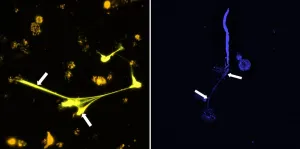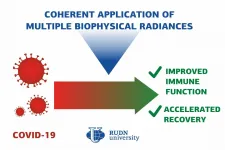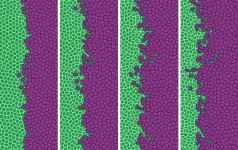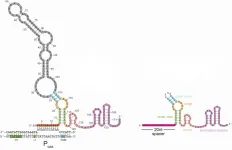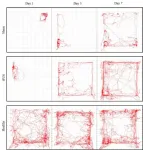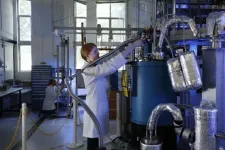(Press-News.org) A new study published in PNAS finds that aid provided by the United Nations (UN) in the aftermath of climate-related disasters is driven by humanitarian need rather than by strategic donor interests. The results underline the importance of climate-related hazards for understanding aid disbursements.
The study 'Humanitarian need drives multilateral disaster aid' provides the first estimation of UN climate-related disaster aid worldwide. Although it cannot be entirely ruled out that powerful donor states' interests shape UN aid flows, the UN seems able to fend off donor states' strategic interest and allocate more aid after disasters where hazard severity is greatest and need is most pressing.
Threats to human livelihoods from natural hazards are increasing due to climate change. Climate-related disasters such as floods, storms and droughts have destroyed homes, reduced crop yields, harmed livestock, and fueled conflict, especially in developing countries. To provide adequate disaster relief, states rely on multilateral institutions, particularly the UN.
Yet the determinants of where UN disaster aid is dispursed are poorly understood. To fill this gap, researchers from Stockholm University and Uppsala University, affiliated with the Bolin Centre for Climate Research and the Mistra Geopolitics programme, examined the determinants of UN disaster aid using a dataset of UN aid covering almost 2 000 climate-related disasters between 2006 and 2017.
The principal findings are twofold. First, humanitarian need largely drives UN aid in the aftermath of climate-related disasters. The UN seems able to fend off donor states' strategic interests and allocate more aid after disasters where hazard severity is greatest and need is most pressing. Based on this finding, the study argues that the UN lives up to its stated principles of neutrality, impartiality and independence in disaster aid. The results underpin the legitimacy of the UN to allocate disaster aid.
While the study indicates that humanitarian need is the main driver of UN climate-related disaster aid in the past 15 years, there is another main factor that shapes aid allocation: UN aid appears to mimic emergency official development assistance (ODA), mirroring previous findings from humanitarian aid research.
"Knowing whether the severity of a climatic hazard is important for explaining multilateral aid has implications for what we can do to better alleviate humanitarian crises in the aftermath of climate-related disasters," said Lisa Dellmuth, lead author of the study and Associate Professor of International Relations at Stockholm University and member of Mistra Geopolitics.
Second, the study has important consequences for disaster impact research and provides a way of measuring hazard magnitude. It develops a uniquely global hazard severity measure that, for the first time, compares across different climate-related disaster types, and assesses and bolsters the measurement validity of EM-DAT climate-related disasters, the most widely used database on natural disasters.
"In aid and disaster impact research, there is much uncertainty in existing data on the occurrence and severity of disasters. For example, consequences of future climate change will likely be different from historical climate disruptions", said Frida Bender, co-author of the study and Associate Professor in Meteorology at Stockholm University and the Bolin Centre for Climate Research. "It is quite likely that over this century, unprecedented climate change is going to have significant impacts on extreme weather events, and our study underlines the validity of the widely used EM-DAT dataset on disasters."
The researchers also make clear there is need to further improve the estimation of climate-related aid data (read article in Nature), and that the present study is a contribution in this regard as it provides the first estimation of UN climate-related disaster aid worldwide.
"Understanding the determinants of multilateral climate aid is important not only for increasing the ability of the international community to provide humanitarian assistance, but also for improving resilience in the face of increasing risk of climate-related natural disasters," said Nina von Uexkull, study co-author and senior lecturer in International Relations at Stockholm University and researcher in Mistra Geopolitics.
INFORMATION:
Read the study 'Humanitarian need drives multilateral disaster aid' published in PNAS: Dellmuth LM, Bender F, Jönsson AR, Rosvold EL, von Uexkull N., "Humanitarian need drives multilateral disaster aid", Proc. Natl. Acad. Sci. U.S.A., Vol. 118 (2021). doi: 10.1073/pnas.2018293118.
For interviews or further information, please contact:
Lisa Dellmuth, Department of Economic History and International Relations, Stockholm University: +46-722 933 380, lisa.dellmuth@su.se
Ylva Rylander, Communications Officer, Stockholm Environment Institute and Mistra Geopolitics: +46-731 503 384, ylva.rylander@sei.org
Press Office at Stockholm University
+46-816 40 90, press@su.se
Authors and affiliations
The study is written by Lisa Dellmuth, Frida Bender, Aiden Jönsson, Elisabeth Rosvold, and Nina von Uexkull, Stockholm University, the Bolin Centre for Climate Research, and the Mistra Geopolitics programme.
Lisa Dellmuth is Associate Professor of International Relations; Frida Bender is Associate Professor in Meteorology and affiliated with the Bolin Centre; Aiden Jönsson is a PhD student in Meteorology and affiliated with the Bolin Centre; Elisabeth Rosvold is a postdoc in International Relations; and Nina von Uexkull is a senior lecturer in International Relations, Stockholm University, and former Assistant Professor at the Department of Peace and Conflict Research at Uppsala University. Dellmuth and von Uexkull are researchers in the Mistra Geopolitics programme.
Mistra Geopolitics is a research programme that examines the dynamics of geopolitics, human security and environmental change. The programme brings together a strong interdisciplinary research team consisting of six Swedish core consortium partners:
Stockholm Environment Institute (SEI)
Stockholm International Peace Research Institute (SIPRI)
Linköping University
Uppsala University
Stockholm University
Lund University
The programme also involves numerous stakeholder partners including Swedish government agencies, companies, industry associations and two international partners, E3G and Adelphi. http://www.mistra-geopolitics.org Twitter, #MistraGeopolitics.
Stockholm University contributes to the development of a sustainable democratic society through knowledge, enlightenment and the pursuit of truth, based on critical thinking. Stockholm University contributes actively to society - a role that has characterized the University since its inception in 1878. Stockholm University is an international academic environment, which is an integral part of excellence in research and education.
Filariae, slender but sometimes up to 70 centimeters long nematodes, can set up residence in their host quite tenaciously and cause serious infectious diseases in the tropics. The tiny larvae of the worms are usually transmitted from person to person by mosquitoes, which pick up the larvae from the blood or subcutaneous tissue when they bite and deposit them in the vessels or tissues of their next victim. Researchers led by the University of Bonn (Germany) have now investigated a mechanism by which the immune system attacks the filariae. Certain immune cells, the eosinophil granulocytes, release DNA that forms a kind of web around the larvae and traps them. The researchers ...
Our brains experience significant changes in blood flow and neural activity during sleep, according to Penn State researchers. Such changes may help to clean out metabolic brain waste that builds up during the day.
"We studied the sleep patterns of mice during both rapid eye movement and non-rapid eye movement sleep stages, as well as in different alertness states," said Patrick Drew, Huck Distinguished Associate Professor of Engineering Science and Mechanics, Neurosurgery and Biomedical Engineering.
Mice were chosen for the study because of their brains' remarkable similarity with human brains, said the researchers.
In both mice and humans, non-REM sleep ...
A team of researchers from RUDN University and RLT suggested restoring normal levels of lymphocytes in patients with COVID-19 and other viral diseases by subjecting them to the combined influence of light, magnetic field, and ultrasound. The results of the study were published in the Journal of Photochemistry and Photobiology B: Biology.
Some COVID-19 patients are asymptomatic, while others suffer from complications. To effectively fight coronavirus with drugs and therapeutic methods, scientists and medics have to find out what causes these differences in the course of the disease. A team of scientists from RUDN University together with their colleagues from the international company Radiant Life Technologies (RLT) suggested that the reason might ...
A scientific study carried out by the Universidad Carlos III de Madrid (UC3M) and the Universidad Complutense de Madrid (UCM) has produced a mathematical description of the way in which a tumor invades the epithelial cells and automatically quantifies the progression of the tumor and the remaining cell islands after its progression. The model developed by these researchers could be used to better understand the biophysical characteristics of the cells involved when developing new treatments for wound healing, organ regeneration, or cancer progression.
This research analyses the collective ...
An Academic Analytics Research Center (AARC) study has found greater rates of authorship of open access (OA) research articles among scholars at more prestigious institutions with greater access to resources and job security. "The open access publishing model is growing, and open access successfully democratizes the results of research projects, but it's clear now that some scholars are more likely to be represented in the open access literature" said AARC director and lead author of the study Anthony Olejniczak, Ph.D.
The researchers analyzed characteristics of 182,320 open access authors at American research universities from 2014 through 2018. The study ...
In a series of experiments with laboratory-cultured bacteria, Johns Hopkins scientists have found evidence that there is a second role for the widely used gene-cutting system CRISPR-Cas9 -- as a genetic dimmer switch for CRISPR-Cas9 genes. Its role of dialing down or dimming CRISPR-Cas9 activity may help scientists develop new ways to genetically engineer cells for research purposes.
A summary of the findings was published Jan. 8 in Cell.
First identified in the genome of gut bacteria in 1987, CRISPR-Cas9 is a naturally occurring but unusual group of genes with a potential for cutting DNA sequences in ...
Cerebral infarction, commonly known as ischemic stroke, has a high mortality rate and causes severe damage to nervous cells in the brain owing to the loss of oxygen, which results in limiting body movements. Several technologies, including physiotherapy and brain stimulation techniques, are being developed and tested for the rehabilitation of brain nervous cells damaged by a stroke. In particular, low-intensity focused ultrasound is expected to be effective for rehabilitating neurological diseases such as stroke, as it can excite or inhibit nerve cells by delivering mechanical energy with high precision at the desired position, while ultrasound is penetrating the cranium without requiring a surgical operation.
Korea Institute of Science and Technology (KIST) announced that the research ...
Why is studying spin properties of one-dimensional quantum nanowires important?
Quantum nanowires-which have length but no width or height-provide a unique environment for the formation and detection of a quasiparticle known as a Majorana zero mode.
A new UNSW-led study overcomes previous difficulty detecting the Majorana zero mode, and produces a significant improvement in device reproducibility.
Potential applications for Majorana zero modes include fault-resistant topological quantum computers, and topological superconductivity.
MAJORANA FERMIONS IN 1D WIRES
A Majorana fermion is a composite particle that is its own antiparticle.
Antimatter explainer: Every fundamental particle has a corresponding antimatter particle, with ...
A KAIST team's mathematical modelling shows that the topographic tiling of cortical maps originates from bottom-up projections from the periphery.
Researchers have explained how the regularly structured topographic maps in the visual cortex of the brain could arise spontaneously to efficiently process visual information. This research provides a new framework for understanding functional architectures in the visual cortex during early developmental stages.
A KAIST research team led by Professor Se-Bum Paik from the Department of Bio and Brain Engineering has demonstrated that the orthogonal organization of retinal mosaics in the periphery is mirrored onto the primary visual cortex and initiates ...
Overview:
Third-year doctoral student Toshiaki Takahashi, associate professor Kazuhiro Takahashi, and their research team from the Department of Electrical and Electronic Information Engineering at Toyohashi University of Technology developed a testing chip using semiconductor micro-machining that can detect volatile gasses in exhaled breath in ppm concentrations at room temperature. A polymer that expands and contracts when gas is absorbed is formed on a flexibly deformable nanosheet, and the amount of deformation that occurs when a target gas is absorbed is measured, allowing gas to be detected at high sensitivity. ...

